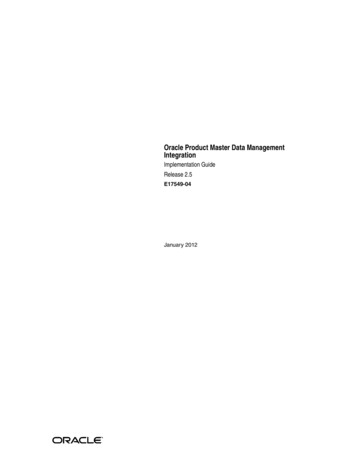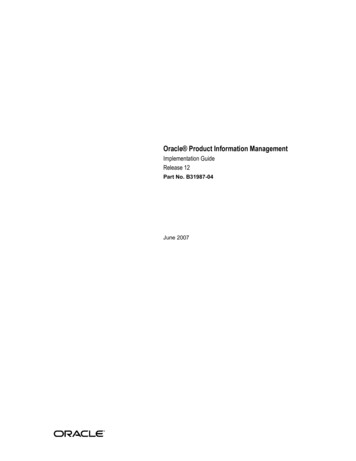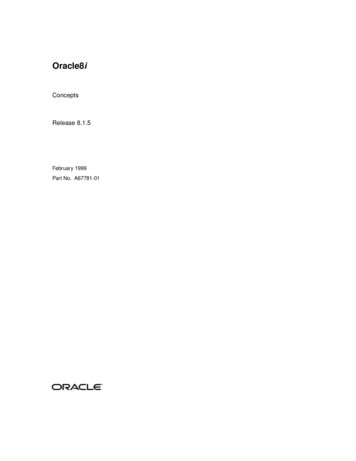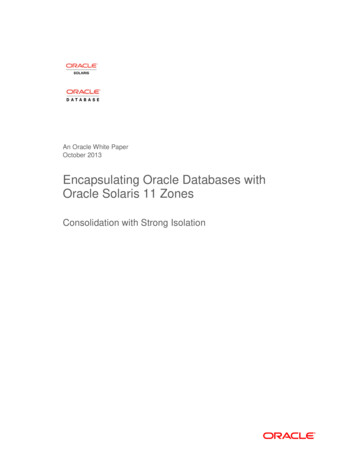
Transcription
Oracle Product Master Data ManagementIntegrationImplementation GuideRelease 2.5E17549-04January 2012
Oracle Product Master Data Management Integration Implementation Guide, Release 2.5E17549-04Copyright 2001, 2012, Oracle and/or its affiliates. All rights reserved.Primary Author:Oracle CorporationThis software and related documentation are provided under a license agreement containing restrictions onuse and disclosure and are protected by intellectual property laws. Except as expressly permitted in yourlicense agreement or allowed by law, you may not use, copy, reproduce, translate, broadcast, modify, license,transmit, distribute, exhibit, perform, publish, or display any part, in any form, or by any means. Reverseengineering, disassembly, or decompilation of this software, unless required by law for interoperability, isprohibited.The information contained herein is subject to change without notice and is not warranted to be error-free. Ifyou find any errors, please report them to us in writing.If this is software or related documentation that is delivered to the U.S. Government or anyone licensing iton behalf of the U.S. Government, the following notice is applicable:U.S. GOVERNMENT RIGHTS Programs, software, databases, and related documentation and technical datadelivered to U.S. Government customers are "commercial computer software" or "commercial technical data"pursuant to the applicable Federal Acquisition Regulation and agency-specific supplemental regulations. Assuch, the use, duplication, disclosure, modification, and adaptation shall be subject to the restrictions andlicense terms set forth in the applicable Government contract, and, to the extent applicable by the terms ofthe Government contract, the additional rights set forth in FAR 52.227-19, Commercial Computer SoftwareLicense (December 2007). Oracle America, Inc., 500 Oracle Parkway, Redwood City, CA 94065.This software or hardware is developed for general use in a variety of information managementapplications. It is not developed or intended for use in any inherently dangerous applications, includingapplications that may create a risk of personal injury. If you use this software or hardware in dangerousapplications, then you shall be responsible to take all appropriate fail-safe, backup, redundancy, and othermeasures to ensure its safe use. Oracle Corporation and its affiliates disclaim any liability for any damagescaused by use of this software or hardware in dangerous applications.Oracle and Java are registered trademarks of Oracle and/or its affiliates. Other names may be trademarks oftheir respective owners.Intel and Intel Xeon are trademarks or registered trademarks of Intel Corporation. All SPARC trademarksare used under license and are trademarks or registered trademarks of SPARC International, Inc. AMD,Opteron, the AMD logo, and the AMD Opteron logo are trademarks or registered trademarks of AdvancedMicro Devices. UNIX is a registered trademark of The Open Group.This software or hardware and documentation may provide access to or information on content, products,and services from third parties. Oracle Corporation and its affiliates are not responsible for and expresslydisclaim all warranties of any kind with respect to third-party content, products, and services. OracleCorporation and its affiliates will not be responsible for any loss, costs, or damages incurred due to youraccess to or use of third-party content, products, or services.
ContentsPreface . iiOracle Application Integration Architecture Foundation Pack Concepts and TechnologiesGuide . iiOracle Application Integration Architecture - Foundation Pack: Integration Developer's Guide. iiiOracle Application Integration Architecture - Foundation Pack: Core InfrastructureComponents Guide . iiiOracle Application Integration Architecture Process Integration Packs . ivAdditional Resources . ivChapter 1: Understanding the Product Master Data Management Integration . 1Overview. 1High-Level Process Flows . 4Core AIA Components . 6AIA Integration Services . 7Chapter 2: Oracle Product Master Data Management Integration Base Pack . 13Overview. 13Synchronization of Items and Bill of Materials from Oracle Product Hub . 14Synchronization of Metadata (value set and item catalog category) from Oracle Product Hub. 59Oracle Product Hub Interfaces . 76Oracle Product Hub Integration Services . 78Assumptions and Constraints. 81Chapter 3: Oracle Product Master Data Management Integration Option for Siebel CRM . 84Overview. 84Siebel CRM Interfaces . 84Siebel CRM Integration Services . 85Chapter 4: Oracle Product Master Data Management Integration Option for Oracle E-BusinessSuite . 88Overview. 88Oracle E-Business Suite Interfaces . 88Oracle E-Business Suite Integration Services . 89Set Up Users and Roles in Oracle E-Business Suite Instance . 91Copyright 2012, Oracle. All rights reserved.ii
ContentsChapter 5: Oracle Product Master Data Management Integration Option for OracleCommunications Billing and Revenue Management . 93Overview. 93Oracle BRM Interfaces . 93Oracle BRM Integration Services . 94Chapter 6: Implementing the Process Integration Pack for Oracle Product Hub . 95Adding a New Spoke Instance . 95Adding an Integration Option or Target Instance for MDM Integration . 99Extracting Organizations and Inventory Locations Data to Setup Cross-References . 100Setting Up Oracle BRM . 108Setting Up Cross-References. 109Identifying Cross-References . 111Describing Domain Value Maps . 113Handling Errors . 118Viewing EBO Implementation Maps (EIMs) . 118Setting Configuration Properties . 119Setting Up the Data for Seeded Attributes of PIM Telco Library. 142Frequently Asked Questions . 145Appendix A . 147Appendix B: User Defined Attributes Framework . 149Extending for Custom UDAs . 149Implementation of UDA Transformation . 152Performance Optimization Using Chunking . 158Appendix C: Cross References for the Process Integration for Product Management . 160Cross Reference Values . 160Integration Solution Cross References . 162Product Synchronization Flow . 162Discount Synchronization Flow . 176Index . 179Copyright 2012, Oracle. All rights reserved.iii
PrefaceThis preface discusses: The Oracle Application Integration Architecture - Foundation Pack: Concepts andTechnologies Guide Oracle Application Integration Architecture - Foundation Pack: Integration Developer's Guide Oracle Application Integration Architecture - Foundation Pack: Core InfrastructureComponents Guide Oracle Application Integration Architecture Process Integration Packs Additional resourcesOracle Application Integration ArchitectureFoundation Pack Concepts and TechnologiesGuideThe Oracle Application Integration Architecture - Foundation Pack: Concepts and TechnologiesGuide is a companion volume to the Oracle Application Integration Architecture - FoundationPack: Core Infrastructure Components Guide and Oracle Application Integration Architecture Foundation Pack: Integration Developer's Guide. The Oracle Application Integration Architecture Foundation Pack: Concepts and Technologies Guide provides definitions of fundamental OracleApplication Integration Architecture (AIA) concepts and discusses: Oracle AIA. Enterprise business objects and enterprise business messages. Enterprise business services. Application business connector services. Interaction patterns. Extensibility. Versioning. Business processes. Batch processing. Infrastructure services. Security.Copyright 2012, Oracle. All rights reserved.ii
PrefaceOracle Application Integration Architecture Foundation Pack: Integration Developer's GuideOracle Application Integration Architecture - Foundation Pack: Integration Developer's Guide is acompanion volume to Oracle Application Integration Architecture - Foundation Pack: Conceptsand Technologies Guide and Oracle Application Integration Architecture - Foundation Pack: CoreInfrastructure Components Guide.The Oracle Application Integration Architecture - Foundation Pack: Integration Developer's Guidediscusses how to: Create an integration scenario. Define business service patterns. Design and develop enterprise business services. Design and develop enterprise business flows. Design and construct Application Business Connector Services (ABCS). Work with message transformation, enrichment, and configuration. Develop custom XPath functions. Design and construct JMS Adapter services. Work with enterprise message headers. Work with message routing. Work with transactions. Develop Oracle Application Integration Architecture (AIA) services to work with the CAVS. Configure Oracle AIA processes to be eligible for error handling and logging. Extend enterprise business objects (EBOs).In addition, this book provides: AIA naming standards. Sample and template WSDLs for use with Oracle AIA.Oracle Application Integration Architecture Foundation Pack: Core InfrastructureComponents GuideOracle Application Integration Architecture - Foundation Pack: Core Infrastructure ComponentsGuide is a companion volume to Oracle Application Integration Architecture – Foundation Pack:Concepts and Technologies Guide and Oracle Application Integration Architecture – FoundationPack: Integration Developer's Guide.
PrefaceOracle Application Integration Architecture - Foundation Pack: Core Infrastructure ComponentsGuide discusses how to: Work with the Composite Application Validation System (CAVS). Work with the Business Service Repository (BSR). Set up and use error handling and logging. Work with the diagnostics framework.Oracle Application Integration ArchitectureProcess Integration PacksA process integration pack (PIP) is a prebuilt set of integrated orchestration flows, applicationintegration logic, and extensible enterprise business objects and services required to manage thestate and execution of a defined set of activities or tasks between specific Oracle applicationsassociated with a given process. A PIP provides everything you need to deploy a selectedintegrated business process area. The PIP product offering is suited to those customers seekingfor rapidly implementation of a discreet business process.Additional ResourcesThese resources are available:ResourceLocationAIA Pre-Built Integration Implementation GuidesOracle Technology Network:http://download.oracle.com/docs/cd/E24010 01/index.htmFoundation Pack GuidesOracle Technology Network:http://download.oracle.com/docs/cd/E21764 01/aia.htmInstallation and Upgrade GuideOracle Technology Network:http://download.oracle.com/docs/cd/E24010 01/index.htmRelease NotesOracle Technology Network:http://download.oracle.com/docs/cd/E24010 01/index.htmVisit the My Oracle Support website frequently to keep apprised of ongoing changes.For other sources of documentation, visit Oracle Technology Network: Oracle Documentation.For training opportunities, visit Oracle University.Copyright 2012, Oracle. All rights reserved.iv
Chapter 1: Understanding the ProductMaster Data Management IntegrationThis chapter provides an overview of the Oracle Product Hub process integration pack andcovers: Overview High-level process flows Core AIA Components AIA Integration ServicesOverviewThe process integration pack for Oracle Product Hub (or Product Information Management [PIM])provides industry-neutral and application integration architecture (AIA) based enterprise-datamanagement solution that enables customers to centralize all product information fromheterogeneous systems to create a single view of product information. This product-masteringsolution harnesses the power and the flexibility of the best-in-class front office and back-officeapplications.Oracle Product Hub provides a flexible user-defined attribute (UDA) framework that enables thisinformation to be modeled in several ways so that a single definition of an entity can beestablished and then later propagated across multiple participating applications.Oracle Product Hub Process Integration Pack (PIP) supports concept to start process where themetadata, items, and BOMs are defined in Oracle Product Hub and published to the registeredtarget applications. Oracle Product Hub PIP also supports component exclusions and overrides incontext of items and BOMs, and PIM Telco library (a set of seeded attributes in Oracle ProductHub to support cross industry application entities). The PIM Telco library can be used to modelcommunications related entities such as billable products, discounts, pricing, rules such ascompatibility, upgrade and downgrade, promotions, promotion commitments and charges,promotion based discounting, and so on.Customers have an option to select one or more participating applications when they installOracle Product Hub except for Oracle BRM, which is a patch installation. In addition, the OPHPIP can be configured to route the messages to only the intended applications. This eliminatesthe need for publishing the entire payload to applications that are not affected by the datachange. The process integration sends the publishing status back to the Oracle Product Hub,which is maintained for each target application at the entity level.The details about the integration flows from Oracle Product Hub to the integration options arecovered in Chapter 2: Oracle Product Master Data Management Integration Base Pack.Similarly, the integration flows from an integration option to Oracle Product Hub, as applicable,along with the services and interfaces involved are covered as under:Copyright 2012, Oracle. All rights reserved.1
Chapter 1: Understanding the Product Master Data Management Integration Chapter 3: Oracle Product Master Data Management Integration Option for Siebel CRM. Chapter 4: Oracle Product Master Data Management Integration Option for Oracle EBusiness Suite. Chapter 5: Oracle Product Master Data Management Integration Option for OracleCommunications Billing and Revenue ManagementThe application and middleware components supported by Oracle Product Hub PIP are asfollows: Fusion Middleware Foundation Pack Oracle Product Hub Siebel Customer Relationship Management (CRM) Oracle E-Business Suite Oracle Billing and Revenue Management (BRM)For more information about how to install participating applications (integration options) basedon your business need, see Oracle Application Integration Architecture 2.5: Installation andUpgrade Guide and Oracle Product Master Data Management Integration Option for OracleCommunications Billing and Revenue Management 2.5: Installation Guide Addendum.TerminologyThis section contains the common terminology used in this guide and some key differences in theterminology across the participating applications.TermDefinitionItem Catalog CategoryItem catalog categories provide a logical classification of items that have similarcharacteristics. Item catalog categories support hierarchies that provide amechanism to inherit attributes and relationships to sub-categories and products thatbelong to categories.Transaction AttributesThese attributes are associated to the Item Catalog Category. The attribute definitionand associated valuesets (domain, values) for the attributes are defined at the timeof definition of the item catalog category. The attributes are then inherited by theproduct.The value of the attribute in the product is captured at run-time during a businesstransaction such as a sales order or a quote. These kinds of attributes capturecharacteristic/properties of a transaction involving a specific instance of a product.Static AttributesCopyright 2012, Oracle. All rights reserved.These attributes are associated to the item catalog category. The attribute definitionand associated valuesets (domain, values) for the attributes are defined at the timeof definition of the item catalog category. The attributes are then inherited by the2
Chapter 1: Understanding the Product Master Data Management IntegrationTermDefinitionproduct.The value of the attribute in the product is captured at design-time while defining theproduct. These attributes capture characteristics/ properties or features of a product.StructureA structure or a bill of material (BOM) can be defined as a listing of the all the subassemblies, intermediates, parts, and raw materials that go into making the parentassembly that displays the quantities of each sub-assembly required to make theassembly. Structure (BOM) is used to compose complex products out of simplerproducts.RelationshipsA relationship captures the relationship of one entity to another for businesspurposes. For example, substitute items, up-sell, cross-sell, and so on. Theitems/BOMs are added as relationships to the ICC.User-defined AttributesUser-defined attributes capture all the detailed information (such as cost information)about an object (items, change requests or change orders). The item catalog enablesyou to create user-defined attributes that use validation logic to support the needs ofyour organization. To do this, create valuesets and associate the valuesets with userdefined attributes. Attributes can have a static or dynamic list of values or a range ofvalues.ValuesetsValuesets define the possible set of values that can be assigned for an attribute. Forthe UDA, the values are assigned at design time and for transaction attributes thevalues are assigned at run time.For more information about the terminology used in this guide, see the product documentationfor the relevant participating application.Some key differences in the terminology used by each application while referring to the sameentity include the following:EntityOPHSiebel CRMOracle EBusiness SuiteOracle BRMInventory location orinventory organizationInventoryorganizationInventory locationInventoryorganizationN/AProduct structureBOMCustomizableProductBOMN/ABusiness unit or operatingunitOperating UnitBusiness UnitOperating oductN/ADiscountProduct ClassItem CatalogCategoryProduct ClassN/AN/ACopyright 2012, Oracle. All rights reserved.2
Chapter 1: Understanding the Product Master Data Management IntegrationEntityAttribute GroupsCopyright 2012, Oracle. All rights reserved.OPHAttribute GroupsSiebel CRMN/AOracle EBusiness SuiteN/AOracle BRMN/A3
Chapter 1: Understanding the Oracle Product Master Data Management IntegrationEntityOPHSiebel CRMOracle EBusiness SuiteOracle BRMStatic AttributesStatic attributes(Seeded)Fields or FirstClass Attributes ofProductOperationalAttributesFields or FirstClassAttributes ofProductTransaction AttributesTransactionAttributesAttributes ofProduct ClassN/AN/AValueset of static attributesValuesets of staticattributesList of ValuesN/AN/ADynamic or VersionedvaluesetsValuesets (dynamicor versioned valuesets)AttributeDefinitionsN/AN/ACustomer Added StaticUDACustomer addedstatic UDAFlexible AttributesN/ACustomeradded FieldsStructure Elements of ICCStructure elementsof the ICCRelationships/Structure of theProduct ClassN/AN/AHigh-Level Process FlowsThese are the high-level process flows as part of Oracle Product Hub PIP: Synchronization of items and bill of materials. Synchronization of item catalog categories. Synchronization of valuesets.For more information about the synchronization flows from Oracle Product Hub to theintegration options, see Chapter 2: Oracle Product Master Data Management Integration BasePack.This diagram shows the business process flow between the Oracle Product Hub and one or moreparticipating applications, as applicable.Copyright 2012, Oracle. All rights reserved.4
Chapter 1: Understanding the Product Master Data Management IntegrationBusiness Process FlowThe business-process related tasks, which provide a contextual framework for the solutioncovers:1. The product administrator defines a common product data model by using item catalogcategory (ICC) in Oracle Product Hub with a comprehensive definition of the products. Afterthe ICC is defined, the product administrator creates or updates new product definitionsthrough the life-cycle of the product from concept to launch and then onto obsolescence. The valuesets can be published independently or during the ICC publish from the OracleProduct Hub (PIM) publication framework. The publication framework provides a user interface to publish item catalog categories toone or more downstream participating applications. The downstream applications have tobe registered within publication framework.2. The launching of a new product and its maintenance includes the following: Item catalog definition and hierarchy ICC (Siebel product classes).Attribute definitions and their association with ICC and attribute metadata that mayinclude attributes’ valueset or any other data of the attribute. Basic item information such as name, product line, description, and so on. ThisCopyright 2012, Oracle. All rights reserved.5
Chapter 1: Understanding the Product Master Data Management Integrationinformation is captured in primary and user-defined attributes in Oracle Product Hub. Inaddition, Oracle Product Hub supports seeded operational attributes that control thebehavior of the item in various functional Oracle E-Business Suite modules like ordermanagement and procurement. The operational attributes are part of the definition of theitem and are intended for consumption by Oracle E-Business Suite. Item bill of material (BOM) information (hierarchical structure of the product withcomponents).This structure also includes the component-level attributes and attributes related to therelationship between parent and child items in a hierarchical relationship. It is desirable tohave BOM synchronization with item definitions and a separate BOM synchronizationprocess without item definitions that may be needed in certain cases.3. After you create or update the common set of data, the product administrator publishes theinformation to the participating applications. The publish mechanism is triggered through thepublication framework provided by Oracle Product Hub. The process integration sends thepublishing status back to the Oracle Product Hub. The status is maintained for each targetapplication spoke at each entity level.For more information about the concepts and terms related to Oracle Product Hub, see OracleProduct Information Management documentation.Core AIA ComponentsThe core application integration architecture (AIA) components used by the integration are asfollows: ItemEBO SyncItemListEBM SyncItemListResponseEBM BillOfMaterialsEBO SyncBillOfMaterialsListEBM SyncBillOfMaterialsListResponseEBM PriceListEBO SyncPriceListEBM SyncPriceListResponseEBM SpecificationValueSetEBOCopyright 2012, Oracle. All rights reserved.6
Chapter 1: Understanding the Product Master Data Management Integration SyncSpecificationValueSetListEBM SyncSpecificationValueSetListResponseEBM ClassificationSchemeEBO SyncClassificationSchemeListEBM SyncClassificationSchemeListResponseEBM Communications/PriceListEBO Communications/ItemCompositionEBO SyncItemCompositionListEBM SyncItemCompositionListResponseEBMThe core EBO and EBM XSD files can be located by EBO within this parent ObjectLibrary/Core/EBO/.The core EBS WSDL files can be located by EBO within this parent BusinessServiceLibrary/Core/EBO/.For detailed documentation of individual enterprise business objects, click EBO Name link on theIntegration Scenario Summary page in the Oracle AIA Console. You can also use theIntegration Scenario Summary page to search for and view integration scenarios that use aparticular EBO or EBS.For more information, see Oracle Application Integration Architecture - Foundation Pack: CoreInfrastructure Components Guide, “Using the BSR,” Using the BSR UI to View IntegrationScenarios.EBOs can be extended, for example, to add new data elements. These extensions remainprotected and are intact even after you apply a patch or an upgrade.For more information, see Oracle Application Integration Architecture – Foundation Pack:Integration Developer’s Guide, “Extensibility for AIA Artifacts.”AIA Integration ServicesThese are the AIA integration services delivered with this integration: ItemEBSV2 ItemResponseEBSV2 BillOfMaterialsEBS BillOfMaterialsReponseEBS PriceListEBSV2Copyright 2012, Oracle. All rights reserved.7
Chapter 1: Understanding the Product Master Data Management Integration PriceListResponseEBSV2 SpecificationValueSetEBS SpecificationValueSetResponseEBS ClassificationSchemeEBS ClassificationSchemeResponseEBS CommunicationsPriceListEBSV2 CommunicationsPriceListResponseEBSV2 CommunicationsItemCompositionEBSV1 CommunicationsItemCompositionResponseEBSV1For more information about EBSs, see Oracle Application Integration Architecture – FoundationPack: Integration Developer’s Guide, “Designing and Developing Enterprise Business Services”and Oracle Application Integration Architecture – Foundation Pack: Concepts and TechnologiesGuide, “Understanding Enterprise Business Services.”ItemEBSV2ItemEBSV2 is implemented as an ESB routing service. It exposes all of the enterprise operationsthat can be performed with a
† Chapter 4: Oracle Product Master Data Management Integration Option for Oracle E-Business Suite. † Chapter 5: Oracle Product Master Data Management Integration Option for Oracle Communications Billing and Revenue Management The application and middleware components supported by Oracle Product Hub PIP are as










